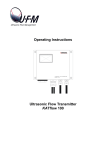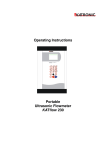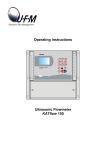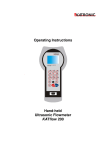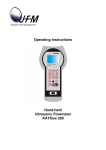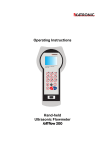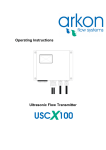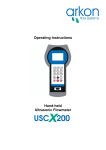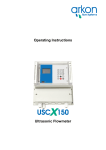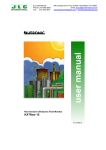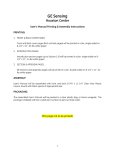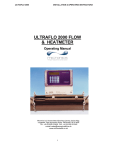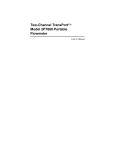Download KATflow150-Manual
Transcript
Operating Instructions Ultrasonic Flowmeter KATflow 150 Katronic Technologies Ltd. 23 Cross Street Leamington Spa Warwickshire CV32 4PX United Kingdom Tel. +44 (0)1926 882954 Fax +44 (0)1926 338649 Internet www.katronic.co.uk E-mail [email protected] Operating Instructions KATflow 150 Version V10E0608 Copyright © 2008 All rights reserved. KATflow 150 Table of Content KATflow 150 Operating Instructions Table of Content Page 1 Safety instructions, legal requirements, warranty, return policy..................7 1.1 Symbols used in these operating instructions...............................................7 1.2 Safety instructions.........................................................................................7 1.3 Warranty........................................................................................................8 1.4 Return policy.................................................................................................8 1.5 Legislative requirements...............................................................................8 2 Introduction........................................................................................................9 2 Installation..........................................................................................................10 2.1 Unpacking and storage.................................................................................10 2.1.1 Unpacking..............................................................................................10 2.1.2 Storage and preservation.......................................................................10 2.1.3 Identification of components..................................................................10 2.2 Clamp-on sensor installation.........................................................................11 2.3 Installation location........................................................................................11 2.4 Pipe preparation............................................................................................13 2.5 Clamp-on sensor mounting configurations and sensor spacing...................14 2.6 Transmitter installation..................................................................................15 2.6.1 Wall mounting........................................................................................15 2.6.2 Electrical interconnections.....................................................................17 2.7 Clamp-on sensor mounting...........................................................................18 2.7.1 Sensor pipe mounting configurations.....................................................18 2.7.2 Acoustic coupling gel.............................................................................18 2.7.3 Correct positioning of the sensors.........................................................19 2.7.4 Sensor mounting with tension straps.....................................................19 3 Operation............................................................................................................21 3.1 Switching On/Off...........................................................................................21 3.2 Keypad and display.......................................................................................21 3.2.1 Keypad key functions.............................................................................21 3.2.2 Display functions....................................................................................23 3.3 Quick setup wizard........................................................................................24 3.4 Measurements..............................................................................................26 3.4.1 Main process value (PV) display............................................................26 3-line display format.......................................................................................26 3.4.2 Diagnostic displays................................................................................26 3.4.3 Totalisers................................................................................................27 4 Commissioning..................................................................................................28 4.1 Menu structure..............................................................................................28 4.2 Diagnostics....................................................................................................33 4.3 Display settings.............................................................................................33 4.4 Output configurations....................................................................................33 4.4.1 Serial interface RS 232..........................................................................33 4.4.2 Serial interface RS 485..........................................................................33 4.4.3 Analogue current output 0/4 ... 20 mA...................................................34 4.4.4 Digital Open-Collector output.................................................................34 3 KATflow 150 Table of Content 4.4.5 Digital relay output.................................................................................34 4.5 Input configurations.......................................................................................35 4.5.1 PT100 inputs..........................................................................................35 4.5.2 Analogue current input 0/4 ... 20 mA......................................................35 4.6 Heat quantity measurement (HQM)..............................................................35 4.7 Sound velocity measurement (SVM)............................................................35 4.8 Dual-channel flow calculations (maths functions).........................................36 5 Maintenance.......................................................................................................37 6 Troubleshooting.................................................................................................38 7 Technical data....................................................................................................40 8 Specification.......................................................................................................46 Appendix A...........................................................................................................48 Appendix B...........................................................................................................49 4 KATflow 150 1 Safety instructions, legal requirements, warranty, return policy 1 Safety instructions, legal requirements, warranty, return policy 1.1 Symbols used in these operating instructions ! ! Danger This symbol represents an immediate hazardous situation which could result in a serious injury, death or damage to the equipment. Where this symbol is shown, do not use the equipment further unless you have fully understood the nature of the hazard and have taken the required precautions. Attention This symbol indicates important instructions which should be respected in order to avoid damage or destroy the equipment. Follow the the precautions given in these instructions to avoid the hazard. Call our service team if necessary. Call service Where this symbol is shown call our service team for advise if necessary. ☞ • <BRK> Note This symbol indicates a note or detailed set-up tip. This symbol represents enumeration. Operator keys are printed in bold typeface and placed in pointed brackets. 1.2 Safety instructions ● ● ● ● ● ● ● ● Do not install, operate or maintain this flowmeter without reading, understanding and following these operating instructions, otherwise injury or damage may result. Study these operating instructions carefully before the installation of the equipment and save them for future reference. Observe all warnings, notes and instructions as marked on the packaging, on the equipment and those detailed in the operating instructions. For mains powered equipment, protective earthing must be connected. Do not use the instrument with removed or opened covers/doors under wet conditions. Consider the unpacking, storage and preservation instructions to avoid damage to the equipment. Install the equipment and cabling securely and safely according to the respective regulations in place. If the product does not operate normally, please refer to the service and trouble shooting instructions or contact KATRONIC for help. 5 KATflow 150 1 Safety instructions, legal requirements, warranty, return policy 1.3 Warranty ● ● ● Any product purchased from KATRONIC is warranted in accordance with the relevant product documentation and as specified in the sales contract provided it has been used for the purpose for which it has been designed for and operated as outlined in these operating instructions. Misuse of the equipment will immediately revoke any warranty given or implied. Responsibility for suitability and intended use of this ultrasonic flowmeter rests solely with the user. Improper installation and operation of the flowmeter may lead to a loss of warranty. Please note that there are no operator-serviceable parts inside the equipment. Any unauthorised interference with the product will invalidate the warranty. 1.4 Return policy If the flowmeter has been diagnosed to be faulty, it can be returned to KATRONIC for repair using the Customer Returns Note (CRN) attached to the Appendix of this manual. KATRONIC regret that we cannot accept the return of the equipment unless accompanied by the completed CRN for Health & Safety reasons. 1.5 Legislative requirements CE marking The flowmeter is designed to meet the safety requirements in accordance with sound engineering practise. It has been tested and left the factory in a condition in which it is safe to operate. The equipment is in conformity with the statutory requirements of the EC directive and comply with applicable regulations and standards for electrical safety EN 61010 and electro-magnetic compatibility EN 61326. A CE Declaration of Conformity is issued in that respect, a copy of which can be found in the Appendix of these operating instructions. WEEE Directive The Waste Electrical and Electronic Equipment Directive (WEEE Directive) aims to minimise the impact of electrical and electronic goods on the environment, by increasing re-use and recycling and reducing the amount of WEEE going to landfill. It seeks to achieve this by making producers responsible for financing the collection, treatment, and recovery of waste electrical equipment, and by obliging distributors to allow consumers to return their waste equipment free of charge. KATRONIC offers its customers the possibility of returning unused and obsolete equipment for correct disposal and recycling. The Dustbin Symbol indicates that when the last user wishes to discard this product, it must be sent to appropriate facilities for recovery and recycling. By not discarding this product along with other household-type waste, the volume of waste sent to incinerators or landfills will be reduced and natural resources will be conserved. Please use the Customer Return Note (CRN) in the Appendix for the return to KATRONIC. RoHS Directive The European Union’s RoHS (“Restriction of the use of certain Hazardous Substances”) Directive (2002/95/EC) goes into effect on July 1, 2006. All of the instrumentation manufactured by KATRONIC falls under Category 9, Measurement and Control Equipment. Currently this category is exempt from RoHS compliance until at least 2010, when it and other exemptions will be reviewed. Regardless of this, all products manufactured by KATRONIC are compliant with the RoHS Directive. 6 KATflow 150 2 Introduction 2 Introduction Clamp-on transittime flowmeter The KATflow 150 is an ultrasonic flowmeter utilising clamp-on sensors for the measurement of liquids in full closed pipes. Flow measurements can be undertaken without interrupting of the process or interfering with the integrity of the pipeline. The clamp-on sensors are simply attached to the outside of pipes. The KATflow 150 uses ultrasonic signals for the measurement of the flow, employing the so-called transit-time method. Illustration 1: Clamp-on ultrasonic flowmeter configuration Measuring principle Ultrasonic signals are emitted by a first transducer installed on one side of a pipe, reflected on the opposite side and received by a second transducer. These signals are emitted alternatively in the direction of flow and against it. Because the medium in which the signals propagate is flowing, the transit time of the sound signals propagating in the direction of flow is shorter than the transit time of the signal propagating against the direction of flow. The transit-time difference ∆T is measured and allows the determination of the average flow velocity along the path of acoustic propagation. A profile correction is then performed to obtain the average flow velocity over the cross-sectional area of the pipe, which is proportional to the volumetric flow rate. Illustration 2: Transit-time measuring principle 7 KATflow 150 2 Installation 2 Installation 2.1 Unpacking and storage 2.1.1 Unpacking Care should be taken when opening the box containing the flowmeter, any markings or warnings shown on the parcel should be observed prior to opening. The following steps should then be taken: ● ● ● ● ● ● ● ● Unpack the flowmeter in a dry area. The flowmeter should be handled with care and not left in an area where it could be subject to physical shocks. If using a knife to remove packaging care should be taken not to damage the flowmeter or cables. When unpacking the sensor cables suitable lifting equipment should be used as long cables can be heavy. The flowmeter package and contents should be checked for completeness against the delivery note supplied and any missing items reported immediately. The flowmeter package and contents should be checked for signs of damage during transport and any problems reported immediately. The vendor accepts no responsibility for damage or injury caused during the unpacking of the instrumentation supplied. Excess packing materials should be either re-cycled or disposed of in a suitable way. 2.1.2 Storage and preservation If storage or preservation is necessary, the flowmeter and sensors should be stored: ● ● ● ● in a secure location, away from water and harsh environmental conditions, in a way as to avoid damage, small items should be kept together in the bags provided to avoid loss. 2.1.3 Identification of components The following items are typically supplied (please refer to your delivery note for a detailed description of your scope of supply): ● ● ● ● ● ● ● ● KATflow 150 flow transmitter Clamp-on sensors (one pair for single channel operation, two pairs for dual channel operation) Sensor connection cable(s) if not direct sensor connection Sensor mounting accessories Coupling component Operating instructions Project and/or hazardous area documentation (optional) Calibration certificate(s) (optional) 8 KATflow 150 2 Installation 2.2 Clamp-on sensor installation The correct selection of the sensor location is crucial for achieving reliable measurements and a high accuracy. Measurement must take place on a pipe in which sound can propagate (see Acoustic Propagation) and in which a rotationally symmetrical flow profile is fully developed (see Straight Pipe Lengths). The correct positioning of the transducers is an essential condition for error-free measurements. It guarantees that the sound signal will be received under optimal conditions and evaluated correctly. Because of the variety of applications and the different factors influencing the measurement, there can be no standard solution for the positioning of the transducers. The correct position of the transducers will be influenced by the following factors: ● ● ● diameter, material, lining, wall thickness and general condition of the pipe, the medium flowing in the pipe, and the presence of gas bubbles and solid particles in the medium. Check that the temperature at the selected location is within the operating temperature range of the transducers (see Specification). After the sensor location has been selected, make sure that that supplied cable is long enough to reach the flow transmitter mounting location. Ensure that the temperature at the selected location is within the ambient operating temperature range of the flow transmitter (see Specification). Acoustic propagation Acoustic propagation is given when the flowmeter is able to receive sufficient signal from the transmitted ultrasonic pulses. The signals are attenuated in the pipe material, the medium and at each of the interfaces and reflections. External and internal pipe corrosion, solid particles and gas content in the medium do heavily contribute to signal attenuation. Straight pipe lengths Sufficient straight lengths of pipe on the inlet and outlet of the measuring location guarantee an axi-symmetrical flow profile in the pipe for good measurement accuracy. If no sufficient straight lengths of pipe are available for your application, measurements are still obtainable but the uncertainty of the measurement can be compromised. 2.3 Installation location ☞ Select an installation location as per recommendations in Table 1 and try to avoid measuring ● ● ● in the vicinity of deformations and defects of the pipe, near welding seams, where deposits could be building up in the pipe. For a horizontal pipe: Select a location where the transducers can be mounted on the side of the pipe, so that the sound waves emitted by the transducers propagate horizontally in the pipe. Thus, the solid particles deposited on the bottom of the pipe and the gas pockets developing at the top will not influence the propagation of the signal. Correct Incorrect For a free inlet or outlet pipe section: Select the measuring point at a location where the pipe cannot run empty. 9 KATflow 150 2 Installation Correct Disadvantageous Correct Disadvantageous For a vertical pipe: Select the measuring point at a location where the liquid flows upward to insure that the pipe is completely filled. Correct Incorrect Table 1: Recommendations for sensor mounting location ☞ Look for a sensor installation location with sufficient straight pipe to obtain accurate measurements. Please refer to Table 2 as a guideline for recommended distances to disturbance sources. Disturbance source: 90°-elbow Inlet Outlet L ≥ 10 D L≥5D Disturbance source: 2 x 90°-elbows in one plane Inlet Outlet L ≥ 25 D L≥5D 10 KATflow 150 2 Installation Disturbance source: 2 x 90°-elbows in different pla nes Inlet Outlet L ≥ 40 D L≥5D Disturbance source: T-section Inlet L ≥ 50 D Outlet L ≥ 10 D Disturbance source: diffuser Inlet L ≥ 30 D Outlet L≥5D Disturbance source: reducer Inlet L ≥ 10 D Outlet L≥5D Disturbance source: valve Inlet L ≥ 40 D Outlet L ≥ 10 D Disturbance source: pump Inlet L ≥ 50 D Table 2: Recommended distances from disturbance sources 2.4 Pipe preparation ☞ ● ● Clean the pipework from dirt and dust around the area where the sensors shall be placed. Remove loose paint and rust with a wire brush or file. Firmly bonded paint does not necessarily need to be removed down to bare metal provided the flowmeter diagnostics indicate sufficient signal level strength. 11 KATflow 150 2 Installation 2.5 Clamp-on sensor mounting configurations and sensor spacing Reflection Mode The most common clamp-on sensor mounting configuration is the Reflection Mode, also known as V-Mode (see Illustration 3, sketch (1). Here the ultrasonic signal pass twice through the medium (2 signal passes). The Reflection Mode is the most convenient mounting method as the sensor spacing distance can be measured easily and the sensors can be perfectly aligned. This method should be used whenever possible. Diagonal Mode An alternative mounting configuration (Illustration 3, sketch (3)) is the Diagonal mode (Z-Mode = 1 signal pass). The signals travel here only once through the pipe. This method is often used especially for larger pipes where greater signal attenuation might occur. Further variation of the Reflection and the Diagonal Mode are possible by altering the number of passes through the pipe. Any even number of passes would require to mount the sensors on the same side of the pipe, whereas with any odd number of passes, the sensors must be mounted on opposite sides of the pipe. Commonly for very small pipes, sensor mounting configurations such as 4 passes (W-mode) or 3 passes (N-mode) are used (Illustration 3, sketch (2)). Illustration 3: Clamp-on sensor mounting configurations and sensor spacing Sensor spacing ☞ The sensor spacing distance A is measured from the edges of the sensor heads facing each other as shown in illustration 3. It is automatically calculated by the flowmeter based on the parameter entries for pipe outside diameter, wall thickness, lining material and thickness, medium, process temperature, the sensor type and the selected number of signal passes. A negative separation distance A < 0 can occur for mounting configurations on small pipes where diagonal mode operation has been selected (see Illustration 3, sketch (3). 12 KATflow 150 2 Installation 2.6 Transmitter installation 2.6.1 Wall mounting The KATflow 150 is a wall mounted device and can be installed using 6 suitable screws and wall plugs according to the following drawings. Transmitter outline dimensions 258.5 243.5 263.7 27 90 CRS 236.7 120 CRS 7 5.5 D IA 146.5 81 M20 GLAND Drawing 1: Outline dimensions KATflow 150 ultrasonic transmitter 13 KATflow 150 2 Installation Drilling aid for wall mounting 90 CRS 120 CRS 243.5 Drawing 2: Drilling aid for wall mounting ! Make sure that the ambient temperature is within the -10 ... 60 °C operating temperature range specified for the transmitter unit. 14 KATflow 150 2 Installation Electrical wiring 2.6.2 Electrical interconnections Please note that in order to supply the unit with MAINS POWER, the equipment must be protected by suitably sized switches and circuit breakers. 100 ... 200 V AC, 50/60 Hz 10 W 9 ... 36 V DC 10 W ! ! Drawing 3: Electrical interconnection diagram KATflow 150 transmitter 15 KATflow 150 2 Installation 2.7 Clamp-on sensor mounting Before the sensors can be mounted Sensor mounting ● ● ● ● the installation location should have been determined, a sensor mounting method should be chosen, the transmitter must be mechanically and electrically installed, the sensors must be connected to the transmitter. Depending on which sensor mounting method is being used (V- or Z-Mode), the clamp on sensors are either mounted on the same side of the pipe (Reflection Mode) or on opposite sides of the pipe (Diagonal Mode). The sensor spacing is calculated by the flowmeter from the pipe parameters entered. 2.7.1 Sensor pipe mounting configurations Diagonal mode Reflection mode A A A<0 A= Transducer distance 080114_1 Illustration 4: Sensor pipe mounting configurations 2.7.2 Acoustic coupling gel ☞ In order to obtain acoustical contact between the pipe and the sensors, apply a bead of acoustic coupling gel lengthwise down the centre of the contact area of the sensors. 100_080114_1 Illustration 5: Application of acoustic coupling gel 16 KATflow 150 2 Installation 2.7.3 Correct positioning of the sensors Correct sensor position 080114_1 Illustration 6: Correct positioning of the sensors Always mount the transducer pair such that the free front edges of the sensors face each other. ☞ There is a different engraving on the top of each transducer. The transducers are mounted correctly if the engravings on the two transducers are forming an arrow together. The transducer cables should then show in opposite directions. Later, the arrow, in conjunction with the indicated measured value, will help to determine the direction of flow. The sensor spacing is automatically calculated by the flowmeter based on the parameter entries for pipe outside diameter, wall thickness, lining material and thickness, medium, process temperature, the sensor type and the selected number of signal passes (see chapter Operation). 2.7.4 Sensor mounting with tension straps Drawing 4: Metallic mounting straps ● ● ● ● ● Cut the tension straps to the appropriate length (circumference + 120 mm). Pull approximately 2 cm of the tension strap through the slot in the clamp and bend the strap back to secure the clamp to the tension strap. Guide the other end of the tension strap through the groove on top of the sensor. Place the sensor onto the prepared pipe section. Hold the clamp on the transducer with one hand and guide the tension strap around the pipe. 17 KATflow 150 2 Installation ● ● ● ● Pull the tension strap and guide the free end through the clamp so that the clamp hooks engage. Slightly tighten the screw on the clamp. Mount the second sensor in the same way. Press the sensors firmly to the pipe. There should be no air pockets between the transducer surface and the pipe wall. Using a measuring tape, adjust the sensor separation distance as suggested by the flowmeter. Illustration 7: Sensor mounting with tension straps and clamps 18 KATflow 150 3 Operation 3 Operation 3.1 Switching On/Off Switching On/Off The flowmeter is switched on by applying the power supply to the instrument. Equally it can be switched off by disconnecting the external supply. 3.2 Keypad and display Display RS 232 Serial Interface Keypad Illustration 8: Keypad and display overview 3.2.1 Keypad key functions Key Keypad Main function Secondary function Alphanumerical entry: 1 (1 short key stroke) , (2 short key strokes) . (3 short key strokes) _ (4 short key strokes) Show NEXT available screen item within display category, i.e next measurement screen, next diagnostic screen Alphanumerical entry: A B C 2 / QON = Starts and resets totaliser function Alphanumerical entry: D E F 3 ? Toggles to next DISPlay category, i.e. measurement displays, diagnostic displays 19 KATflow 150 3 Operation Alphanumerical entry: G H I 4 < Q- = Show negative total value Alphanumerical entry: J K L 5 > Alphanumerical entry: M N O 6 $ Q+ = Show positive total value Alphanumerical entry: P Q R S 7 Toggle MUltipleXer (for multi-channel functionality) Alphanumerical entry: T U V 8 * QOFF = Stop totaliser function, holds totaliser value until QON is pressed again Alphanumerical entry: W X Y Z 9 DIRECT access to password protected settings Move menu/list selection cursor UP Alphanumerical entry: Character backspace clear Numerical entry only: . (decimal point) Switch LCD backlight on/off Alphanumerical entry: 0 Space character + = # Move menu/list selection curs- Numerical entry only: or DOWN - (minus sign) ESCape menu item Abort entry without saving Table 3: Menu structure 20 KATflow 150 3 Operation Confirm entry with saving ENTER menu item 3.2.2 Display functions Main measurement display Display icons Menu header Display line 1 Display line 2 Date, time (optional) Illustration 9: Main measurement display Display icons Display icon Function On Off Not used On Off Datalogger recording Datalogger switched off On Off Not used On Off Backlight switched on Backlight switched off On Off System I/O processor error I/O processor functioning correctly On Off Without strike-through: Speaker on With strike-through: Speaker off On Off Poor sensor coupling, low SNR Sensor coupling OK On Off Not used 21 KATflow 150 3 Operation On Off Not used On Off RTC operating RTC failure On Off Error recorded in error log No error detected On Off Serial communication on (RS232 and/or RS485) Serial communication off Table 4: Display icons 3.3 Quick setup wizard Quick start wizard The quick setup wizard allows for a speedy setup of the most important parameters in order to achieve successful measurements in the shortest possible time: Display screen Operation Upon first power on and the boot-up sequence, the main menu is displayed. Use <UP> and <DOWN> cursor keys to select Quick start. Confirm by pressing <ENTER>. Use cursor keys to select Setup Wizard. Confirm by pressing <ENTER>. Choose pipe material using cursor keys and pressing <ENTER>. Enter outside pipe diameter using alphanumerical keys and confirm by pressing <ENTER>. Use key <UP> as character backspace clear to correct for data entry errors. If 0 is entered, an additional screen appears that allows entering the pipe circumference. 22 KATflow 150 3 Operation Enter pipe wall thickness using alphanumerical keys and confirm by pressing <ENTER>. Use key <UP> as character backspace clear to correct for data entry errors. Select fluid using cursor keys. Confirm by pressing <ENTER>. Enter process temperature using alphanumerical keys and confirm by pressing <ENTER>. Use key <UP> as character backspace clear to correct for data entry errors. Select pipe lining material using cursor keys. Confirm by pressing <ENTER>. Select transducer configuration (number of passes) using cursor keys. Auto 1 2 3 4 5 6 etc. Automatically Z-mode (1 pass), diagonal mode V-mode (2 passes), reflection mode N-mode (3 passes), diagonal mode W-mode (4 passes), reflection mode 5 passes, diagonal mode 6 passes, reflection mode Confirm by pressing <ENTER>. Sensor placement screen: Mount transducers with suggested spacing. Observe signal strength. Confirm by pressing <ENTER> to obtain measurements. 23 KATflow 150 3 Operation Success! Table 5: Quick setup wizard 3.4 Measurements Measurement screens 3.4.1 Main process value (PV) display The measurements are started either through the Quick Setup Wizard or the menu structure by selecting Start Measurement upon first power on. Once all the parameters are programmed, any subsequent power-on sequences will bring up the main PV display immediately. Display screen Operation The main process value can be changed by accessing the menu structure. Press <ESC> at any time to access the main menu. Change to other measurement screens by pressing <NEXT>. 3-line display format Display screen Operation Line 1 shows the Tag ID but is universally configurable through the installation menu. Line 2 displays the main PV. Line 3 displays the flow velocity. Change to diagnostic displays by pressing <DISP>. 3.4.2 Diagnostic displays Diagnostic screens Display screen Operation Line 1 shows the amplifier gain. Line 2 displays the signal strength. Line 3 indicates the correlation value. Change to more diagnostic screens by pressing <NEXT>. 24 KATflow 150 3 Operation 3.4.3 Totalisers The totaliser displays will only be shown when the totalisers are activated. Totalisers Display screen Operation The flow totaliser can be started by pressing <QON>. The grand total is displayed. Pressing <Q+> shows the total accumulated flow in positive flow direction. Pressing <Q-> shows the total accumulated flow in negative flow direction. The totalisers can be stopped by activating <QOFF>. Change to other related display screens by pressing <NEXT>. 25 KATflow 150 4 Commissioning 4 Commissioning 4.1 Menu structure Menu structure Main menu Menu level 1 Menu level 2 Description/settings Quick Start Setup Wizard Single Units Select from list ↑↓ m/s f/s in/s m3/h m3/min m3/s l/h l/min l/s USgall/h USgall/min USgall/s bbl/d bbl/h bbl/min g/s t/h kg/h kg/min Pipe material Select from list ↑↓ Stainless steel Carbon steel Ductile cast iron Grey cast iron Copper Lead PVC PP PE ABS Glass Cement User (pipe c-speed) Pipe c-speed Only if user pipe material selected 600 ... 6553.5 m/s Outside diameter 6 ... 6500 mm Wall thickness 0.5 ... 75 mm Fluid Select from list ↑↓ Water Salt water Acetone Alcohol Ammonia Carbon Tet Ethanol Ethyl alcohol Ethyl ether Ethylene glycol Glycol/water 50% Kerosene Methanol Methyl alcohol Milk Naphtha Car oil Freon R134a 26 KATflow 150 4 Commissioning Freon R22 Hydrochloric acid Sour cream Sulphuric acid Toluene Vinyl chloride User (kinematic viscosity, density, medium cspeed) Kinematic viscosity Only if user fluid selected 0.001 ... 30000 mm2/s Density Only if user fluid selected 100 ... 2000 kg/m3 Medium cspeed Only if user fluid selected 800 ... 3500 m/s Temperature -30 ... 300 °C Liner Material Select from list ↑↓ None Epoxy Rubber PVDF PP Glass User (liner c-speed) Liner c-speed Only if lining material selected 600 ... 6553.0 m/s Liner thickness Only if lining material selected 1.0 ... 99.0 mm Passes Select from list ↑↓ Auto 1 2 3 4 5 6 etc. Sensor type Indication of sensor type and serial number if automatically detected, otherwise select from list ↑↓ K1 K4 M Q Special Sensor frequency SP1, only for special, unrecognised sensors Wedge angle SP2, only for special, unrecognised sensors Wedge cspeed 1 SP3, only for special, unrecognised sensors Wedge cspeed 2 SP4, only for special, unrecognised sensors Crystal offset SP5, only for special, unrecognised sensors Spacing offset SP6, only for special, unrecognised sensors Zero flow offset SP7, only for special, unrecognised sensors Upstream offset SP8, only for special, unrecognised sensors Sensor placement Setup Wizard Dual As per setup wizard single for channel 1 Repeat for channel 2 27 KATflow 150 4 Commissioning Start Measurement Sensor type Indication of sensor type and serial number if automatically detected, otherwise select from list ↑↓ K1 K4 M Q Special SP 1 ... SP 8 Only for special, unrecognised sensors Sensor placement Installation Pipe Material Select from pipe material list ↑↓ Outside diameter 6 ... 6500 mm Wall thickness 0.5 ... 75 mm Pipe c-speed 600 ... 6553.5 m/s Pipe circumfer- 18.8 ... 20420.4 mm ence Roughness 0.0 ... 10 mm Medium Fluid Select from fluid list ↑↓ Kinematic viscosity 0.001 ... 30000 mm2/s Density 100 ... 2000 kg/m3 C-speed 800 ... 3500 m/s Temperature -30 ... 300 °C Lining Material Select from material list ↑↓ Thickness 1 ... 99 mm C-speed 600 ... 6553.0 m/s Passes Select from list ↑↓ Units Select from unit list ↑↓ Damping Smooths the display output, the higher the damping factor 1 ... 255 s Mode Yes – Current output on No – Current output off Min Value Min. process variable (PV) value that corresponds to 0/4 mA Max Value Max. process variable (PV) value that corresponds to 20 mA Damping Additional smoothing of the current output, the higher the damping factor 1 ... 255 s Passes Output Display Current Open Collector 28 KATflow 150 4 Commissioning Mode Yes – Pulse output on No – Pulse output off Pulse Value Totaliser value of selected PV at which a pulse is generated, e.g. PV = [m3/h], Pulse Value = 10, a pulse is output every 10 m3 0.01 ... 1000 Pulse Width Width of the pulse 30 ... 999 ms Calc. Max This is the calculated max. number of pulses per second., i.e. the max. pulse rate in Hz Mode Off – Permanently off On – Permanently energised Alarm – PV alarm switch Fault – Allocated to system failures, see error report list On Point Value of PV at which the relay energises when in alarm m ode Off Point Value of PV at which the relay de-energises when in alarm m ode Current IP Log Yes – If serial output is turned on, mode printer, then the current input value is output via serial communication No Source Fixed – A fixed temperature can be entered under value PT100 – Value read from PT100 temperature sensor in ºC Value Enter fixed user defined value 0 ... 250 ºC Model Code 150 Serial No. Example: 90000003 HW Revision Example: 1.0, 1.0 SW Revision Example: 1.0, 1.0 Low F Cut ± Low flow velocity cut off 0 ... 0.25 m/s Max F Cut ± Maximum flow velocity cut off 0 ... 30 m/s Corrected Apply flow velocity profile correction Yes No PV Offset Calibration process variable zero offset -30 ... 30 units PV Scaling Calibration process variable gradient scaling 0 ... 10000 units Relay Input Current Temperature System Instrument info Calculation Zero calibration settings Zero Cal Zero Perform auto zero calibration Yes No Track Track zero offset 29 KATflow 150 4 Commissioning Yes No Delta Zero flow delta time offset in ns, read from sensor PROM or entered directly for special sensors Timeup Upstream transit-time offset in µs, allows for fixed delays in special sensors, buffer rods and extension leads Identifier Example: Pump P3A 9 alphanumeric character string Tag No. Example: 1FT-3011 9 alphanumeric character string Test Mode Control system simulation: 60 second ramping up of flow velocity in m/s from 0 to programmed Max F Cut and subsequent 60 second ramping down, i.e. the process variable would change over complete possible range. All configured outputs will exhibit their programmed behaviour. Yes No Date Example: 03/10/07 Time Example: 09:27:00 Date Format Select from list ↑↓ dd/mm/yy mm/dd/yy yy/mm/dd Language Select from list ↑↓ English German French Spanish Russian Keypad Enable keypad sound Yes No User Test Settings Reload factory default settings, except for date and time Yes No Defaults Diagnostics Temperature Shows control unit temperature Log Memory Percentage of unused datalogger memory remaining Interval A value of zero turns the datalogger off, a nonzero value turns the datalogger on and defines the logging interval. Going from a value of zero to a non-zero value, clears the log memory. 0 ... 999 s Overwrite When the log memory is full, i.e. 0 % remaining, the logger wraps around and starts to overwrite memory. Yes No Low Memory Warning output: The amount of memory remaining at which the flowmeter begins to give an audible warning. 0 ... 100 % Log Download Sends logger content to selected serial commu- Datalogger 30 KATflow 150 4 Commissioning nication port. Serial Comm Mode Select from list ↑↓ None Printer Diagnostic Log download Baud Select from list ↑↓ 2400 9600 (Default) 19200 Parity Select from list ↑↓ None Even (Default) Odd Type Select from list ↑↓ Selects the active serial communication port None RS232 RS485 Table 6: Firmware menu structure 4.2 Diagnostics Diagnostic screens can be accessed directly during measurement or through the menu structure. 4.3 Display settings ☞ The main Process Value (PV) is the primary measurement data. Customer specific settings for data to be displayed can be achieved by accessing the appropriate menu items. The PV can be selected from a list of available items. 4.4 Output configurations Serial interfaces 4.4.1 Serial interface RS 232 The RS 232 serial interface can be used to transmit data on-line or to download the integral datalogger content. The settings can be found in submenu Serial Comm. 4.4.2 Serial interface RS 485 The RS 485 interface is used for networking up to 32 flowmeters to a centralised computer system. Each flowmeter is given an unique address to be able to communicate effectively. The communication protocol used conforms to the conventions of the Modbus RTU protocol, a description of which is given in a separate document. Please refer to customer support for further information. In addition, the ASCII printer output can be redirected through the RS 485 interface rather than the RS 232 to increase the transmission distance. Wiring Setup Please refer to customer support. 31 KATflow 150 4 Commissioning Operation Analogue outputs Please refer to customer support. 4.4.3 Analogue current output 0/4 ... 20 mA The analogue current outputs operate in 4 ... 20 mA mode by default. 0 ... 20 mA operation is possible, please contact customer support. Current output 1 is assigned to the PV of channel 1, output 2 is assigned to the PV of channel 2 (on a two-channel system). The current outputs can be programmed and scaled within the menu structure. Wiring Electrical characteristics Digital outputs Range = 0/4 ... 20 mA Resolution = 16 bit U = 30 V RLoad < 500 Ω Accuracy = 0.1 % Galvanically isolated from main device and other I/O 4.4.4 Digital Open-Collector output Open-Collector output 1 is assigned to the totaliser function of channel 1 which is related to the selected PV. Open-Collector output 2 is assigned in the same way to channel 2 (on a two-channel system). The totaliser function is enabled and controlled using the <QON>, <Q+>, <Q-> and <QOFF> keys and from the menu structure where the pulse value and width are selected. Wiring Electrical characteristics U = 24 V Imax = 4 mA Value = 0.01 ... 1000 Pulse width = 30 ... 999 ms 4.4.5 Digital relay output Relay output 1 is assigned to the PV value of channel 1. Relay output 2 is assigned in the same way to channel 2 (on a two-channel system). The relay outputs are enabled and controlled using the menu structure. 32 KATflow 150 4 Commissioning Wiring Electrical characteristics Form C (SPDT-CO) contacts V = 48 V Imax = 250 mA 4.5 Input configurations 4.5.1 PT100 inputs Inputs Wiring Electrical characteristics PT100 4-wire circuit Measuring range = -50 ... 400 ºC Resolution = 0.1 K Accuracy = ±0.2 K 4.5.2 Analogue current input 0/4 ... 20 mA Wiring Electrical characteristics Active or passive wiring Measuring range active = 0 ... 20 mA at 30 V Measuring range passive = 4 ... 20 mA Accuracy = 0.1 % of measured value 4.6 Heat quantity measurement (HQM) Future implementation. 4.7 Sound velocity measurement (SVM) Future implementation. 33 KATflow 150 4 Commissioning 4.8 Dual-channel flow calculations (maths functions) Future implementation 34 KATflow 150 5 Maintenance 5 Maintenance No general maintenance is required for this equipment. 35 KATflow 150 6 Troubleshooting 6 Troubleshooting Should there be the need to call customer service, please let us know the following details: ● ● ● ● Model code Serial number SW, HW revision Error log list Possible error messages may include the following: Error list Error message Group Description Error handling USB INIT FAIL Hardware Internal board communic- Power on/off, otherwise ation error call customer support NO SERIAL NO. Hardware Failed to read from FRAM Call customer support NO VERSION NO. Hardware Failed to read from FRAM Call customer support PARA READ FAIL Hardware Failed to read from FRAM Load defaults, otherwise call customer support PARA WRITE FAIL Hardware Failed to write to FRAM VAR READ FAIL Hardware Failed to read from FRAM Call customer support VAR WRITE FAIL Hardware Failed to write to FRAM SYSTEM ERROR Hardware Call customer support VISIBILITY ERR Hardware Failed to read from FRAM Call customer support Load defaults, otherwise call customer support Call customer support FRAM LONG WRITE Hardware ERR Failed to write to FRAM Call customer support FRAM READ ERR Hardware Failed to read from FRAM Call customer support RTC ERR Hardware Real Time Clock failure Power on/off, otherwise call customer support EXTMEM ERR Hardware Logger memory failure Power on/off, otherwise call customer support SPI ERR Hardware SPI bus failure Power on/off, otherwise call customer support I2C ERR Hardware I2C bus failure Power on/off, otherwise call customer support MATH ERR Software Internal calculation error Call customer support STACK ERR Software Internal calculation error Call customer support ADDR ERR Software Internal calculation error Call customer support OSC ERR Software Internal calculation error Call customer support ADC ERR Software Internal calculation error Call customer support IO ERR Software Internal calculation error Call customer support TIMING ERR Software Internal calculation error Call customer support COMM INIT ERR Hardware Internal communication error Power on/off, otherwise call customer support COMM START ERR Hardware Internal communication error Power on/off, otherwise call customer support COMM HS0 ERR Hardware Internal communication error Power on/off, otherwise call customer support 36 KATflow 150 6 Troubleshooting COMM HS1 ERR Hardware Internal communication error Power on/off, otherwise call customer support COMM READ AVE ERR Hardware Internal communication error Power on/off, otherwise call customer support COMM READ RAW ERR Hardware Internal communication error Power on/off, otherwise call customer support COMM READ HISTORY ERR Hardware Internal communication error Power on/off, otherwise call customer support COMM CRC ERR Hardware Internal communication error Power on/off, otherwise call customer support SENSOR COUPLING ERR Application Weak sensor coupling, low SNR Recouple sensors, check installation, reduce number of passes, look for other location, then have a cup of tea and call customer support! Table 7: Error messages 37 KATflow 150 7 Technical data 7 Technical data Sound Speed* Shear Wave (at 25 ºC) Material Steel, 1% Carbon, hardened Carbon Steel Mild Steel Steel, 1% Carbon 302 Stainless Steel 303 Stainless Steel 304 Stainless Steel 304L Stainless Steel 316 Stainless Steel 347 Stainless Steel Aluminium Aluminium (rolled) Copper Copper (annealed) Copper (rolled) CuNi (70%Cu 30%Ni) CuNi (90%Cu 10%Ni) Brass (Naval) Gold (hard-drawn) Inconel Iron (electrolytic) Iron (Armco) Ductile Iron Cast Iron Monel Nickel Tin (rolled) Titanium Tungsten (annealed) Tungsten (drawn) Tungsten (carbide) Zinc (rolled) Glass (pyrex) Glass (heavy silicante first) Glass (light brate crown) Nylon Nylon, 6-6 Polyethylene (LD) PVC, CPVC Acrylic m/s 3,150 3,230 3,235 3,220 3,120 3,120 3,141 3,070 3,272 3,095 3,100 3,040 2,260 2,325 2,270 2,540 2,060 2,120 1,200 3,020 3,240 3,240 3,000 2,500 2,720 2,960 1,670 3,125 2,890 2,640 3,980 2,440 3,280 2,380 2,840 1,150 1,070 540 1,060 1,430 ft/s 10,335 10,598 10,614 10,565 10,236 10,236 10,306 10,073 10,735 10,512 10,171 9,974 7,415 7,628 7,448 8,334 6,759 6,923 3,937 9,909 10,630 10,630 9,843 8,203 8,924 9,712 5,479 10,253 9,482 8,661 13,058 8,005 10,761 7,808 9,318 3,772 3,510 1,772 3,477 4,690 * Please note these values are to be considered nominal. Solids may be inhomogeneous and anisotropic. Actual values depend on exact composition, temperature, and to a lesser extent, on pressure and stress. 38 KATflow 150 7 Technical data All data given at 25 ºC (77 ºF) unless otherwise stated Change Kinematic Viscosity Sound Speed v/ºC x10-6 Acetic anhydride Acetic acid, anhydride Acetic acid, nitrile Acetic acid, ethyl ester Acetic acid, methyl ester Acetone Acetylene dichloride Alcohol Chemical Formula (CH3CO)2O (CH3CO)2O C2H3N C4H802 C3H6O2 C3H6O C2H2Cl2 C2H6O Specific Gravity 1.082 (20 ºC) 1.082 (20 ºC) 0.783 0.901 0.934 0.791 1.26 0.789 Ammonia NH3 0.771 Benzene Benzol Bromine C6H6 C6H6 Br2 0.879 0.879 2.928 n-Butane(2) C4H10 0.601 (0ºC) 2-Butanol sec-Butylalcohol C4H10O C4H10O 0.81 0.81 n-Butyl bromide (46) C4H9Br 1.276 (20ºC) n-Butyl chloride (22,46) C4H9Cl 0.887 Carbon tetrachloride Carbon tetrafluoride (Freon 14) Chloroform Dichlorodifluoromethane (Freon 12) Ethanol Ethyl acetate Ethyl alcohol CCl4 1.595 (20ºC) Substance m/s ft/s m/s/ºC m2/s ft2/s 1,180 1,180 1,290 1,085 1,211 1,174 1,015 1,207 1,729 (-33 ºC) 1,306 1,306 889 1,085 (-5º C) 1,240 1,240 1,019 (20ºC) 3,871.4 3,871.4 4,232.3 3,559.7 3,973.1 3,851.7 3,330.1 3,960 5,672.6 (-27 ºC) 4,284.8 4284.8 2,916.7 3,559.7 (23 ºC) 4,068.2 4,068.2 3,343.2 (68ºF) 2.5 2.5 4.1 4.4 0.769 0.769 0.441 0.467 0.407 0.399 0.400 1.396 0.292 (-33 ºC) 0.711 0.711 0.323 8.274 8.274 4.745 5.025 4.379 4.293 4.304 15.02 3.141 (-27 ºF) 7.65 7.65 3.475 1,140 3,740.2 3.239 3.239 0.49 (15ºC) 0.529 (15ºC) 0.607 34.851 34.851 5.272 (59ºC) 5.692 (59ºF) 6.531 0.55 5.918 1.39 0.489 1.396 0.797 (17 ºC) 0.311 0.311 0.79 0.61 17,208 (20ºC) 14.956 5.263 15.020 8.575 (63 ºF) 3.346 3.346 8.5 6.563 185.158 (68ºF) 2.718 29.245 2.718 29.245 4.5 3.8 4.0 6.68 4.65 4.65 3.0 5.8 3.3 3.3 4.57 CHCl3 926 875.2 1.75 (-150 ºC) (-150 ºC) 1.489 979 3038.1 2.48 2,871.5 6.61 (-238 ºF) 3,211.9 3.4 CCl2F2 1.516 (40 ºC) 774.1 2,539.7 4.24 C2H6O C4H8O2 C2H6O 0.789 0.901 0.789 C8H10 0.867 (20 ºC) Ether Ethyl ether Ethylene bromide Ethylene chloride C4H10O C4H10O C2H4Br2 C2H4Cl2 0.713 0.713 2.18 1.253 3,960 3,559.7 3,960 4,.89.8 (68 ºF) 3231.6 3231.6 3264.4 3,914 4.0 4.4 4.0 Ethyl benzene 1,207 1,085 1,207 1,338 (20 ºC) 985 985 995 1,193 Ethylene glycol C2H6O2 1.113 1,658 5439.6 Fluorine F Formaldehyde, methyl ester Freon R12 Glycol 50% Glycol/50% H2O C2H4O2 0.545 (-143 ºC) 0.974 C2H6O2 1.113 Isopropanol C3H8O 0.785 (20 ºC) Isopropyl alcohol (46) C3H8O 0.785 (20 ºC) 403 (-143 ºC) 1,127 774.2 1658 1,578 1,170 (20 ºC) 1,170 (20 ºC) 1,324 1322.2 (-225 ºF) 3697.5 2540 5439.6 5,177 3,838.6 (68 ºF) 3,838.6 (68 ºF) 4,343.8 Kerosene CF4 0.81 4.87 4.87 2.1 11.31 4.02 2.1 3.6 39 KATflow 150 7 Technical data Methane CH4 0.162 (-89 ºC) Methanol Methyl acetate Methyl alcohol CH4O C3H6O2 CH4O 0.791 (20 ºC) 0.934 0.791 Methyl benzene C7H8 0.867 Milk, homogenized Naphtha Natural Gas Nitrogen Oil, Car (SAE 20a.30) Oil, Castor Oil, Diesel Oil, Fuel AA gravity Oil (Lubricating X200) Oil (Olive) Oil (Peanut) N2 C11H10O0 0.76 0.316 (-103 ºC) 0.808 (-199 ºC) 1.74 0.969 0.80 0.99 0.912 0.936 Propane (-45 to -130 ºC) C3H8 0.585 (-45 ºC) 1-Propanol C3H8O 0.78 (20 ºC) 2-Propanol C3H8O 0.785 (20 ºC) Propene C3H6 0.563 (-13ºC) n-Propyl-alcohol C3H8O 0.78 (20 ºC) Propylene C3H6 0.563 (-13 ºC) Refrigerant 11 CCl3F 1.49 Refrigerant 12 CCl2F2 1.516 (-40 ºC) Refrigerant 14 CF4 1.75 (-150 ºC) Refrigerant 21 CHCl2F 1.426 (0 ºC) Refrigerant 22 CHClF2 1.491 (-69 ºC) Refrigerant 113 CCl2F-CClF2 1.563 Refrigerant 114 CClF2-CClF2 1.455 Refrigerant 115 C2ClF5 Refrigerant C318 C4F8 1.62 (-20 ºC) Sodium nitrate NoNO3 1.884 (336 ºC) Sodium nitrite NoNO2 1.805 (292 ºC) Sulphur S Sulphuric Acid H2SO4 1.841 405 (-89 ºC) 1,076 1,211 1,076 1,328 (20 ºC) 1,548 1,225 753 (-103 ºC) 962 (-199 ºC) 870 1,477 1,250 1,485 1,530 1,431 1,458 1,003 (-45 ºC) 1,222 (20 ºC) 1,170 (20 ºC) 963 (-13ºC) 1,222 (20 ºC) 963 (-13 ºC) 828.3 (0 ºC) 774.1 (-40 ºC) 875.24 (-150 ºC) 891 (0 ºC) 893.9 (50 ºC) 783.7 (0 ºC) 665.3 (-10 ºC) 656.4 (-50 ºC) 574 (-10 ºC) 1,763.3 (336 ºC) 1876.8 (292 ºC) 1177 (250 ºC) 1,257.6 1,328.7 (-128 ºF) 3,530.2 3,973.1 3,530.2 4,357 (68 ºF) 5,080 4,019 2,470.5 (-153 ºF) 3,156.2 (-326 ºF) 2,854.3 4,845.8 4,101 4,872 5,019.9 4,694.9 4,738.5 3,290.6 (-49 ºF) 4,009.2 (68 ºF) 3,838.6 (68 ºF) 3159.4 (9ºF) 4,009.2 (68 ºF) 3159.4 (9 ºF) 2,717.5 (32 ºF) 2,539.7 (-40 ºC) 2,871.6 (-268 ºF) 2,923.2 (32 ºF) 2,932.7 (122 ºF) 2,571.2 (32 ºF) 2,182.7 (14 ºF) 2,153.5 (-58 ºF) 1,883.2 (14 ºF) 5,785.1 (637 ºF) 6157.5 (558 ºF) 3861.5 (482 ºF) 4,126 17.5 292 292 0.695 0.407 0.695 7.478 4.379 7.478 4.27 0.644 7.144 3.6 0.217 (-199 ºC) 190 0.670 2.334 (-326 ºF) 2,045.093 7.209 100 1,076.365 2.718 29.245 2.549 27.427 1.37 (336 ºC) 14.74 (637 ºF) 11.16 120.081 3.7 2.75 5.7 6.32 6.32 3.56 4.24 6.61 3.97 4.79 3.44 3.73 4.42 3.88 0.74 -1.13 1.43 40 KATflow 150 7 Technical data Tetrachloroethane C2H2Cl4 1553 (20 ºC) Tetrachloro-ethene Tetrachloro-Methane Tetrafluoro-methane (Freon 14) C2Cl4 CCl4 1.632 1.595 (20 ºC) Toluene C7H8 Toluol Trichloro-fluoromethane (Freon 11) Turpentine Water, distilled Water, heavy Water, sea C7H8 CF4 CCl3F H2O D2O 1,170 (20 ºC) 3,838.6 (68 ºF) 1,036 926 875.24 1.75 (-150 ºC) (-150 ºC) 1,328 0.867 (20 ºC) (20 ºC) 0.866 1,308 828.3 1.49 (0 ºC) 0.88 1,255 0.996 1,498 1,400 1.025 1531 3,399 3,038.1 2,871.5 (-283 ºF) 4,357 (68 ºF) 4,291.3 2,717.5 (32 ºF) 4,117.5 4,914.7 4,593 5023 Temperature Sound Speed in Water ºC ºF m/s ft/s 0 32.0 1402 4600 1 2 3 4 5 6 7 8 9 10 11 12 13 14 15 16 17 18 19 20 21 22 23 24 33.8 35.6 37.4 39.2 41.0 42.8 44.6 46.4 48.2 50.0 51.8 53.6 55.4 57.2 59.0 60.8 62.6 64.4 66.2 68.0 69.8 71.6 73.4 75.2 77.0 1407 1412 1417 1421 1426 1430 1434 1439 1443 1447 1451 1455 1458 1462 1465 1469 1475 1476 1479 1482 1485 1488 1491 1493 4616 4633 4649 4662 4679 4692 4705 4721 4734 4748 4761 4774 4784 4797 4807 4820 4830 4843 4853 4862 4872 4882 4892 4899 1496 4908 78.8 80.6 82.4 84.2 86.0 87.8 89.6 1499 1501 1504 1506 1509 1511 1513 4918 4925 4935 4941 4951 4958 4964 25 26 27 28 29 30 31 32 1.19 12.804 0.607 6.531 4.27 0.644 6.929 4.2 0.58 6.24 -2.4 1.4 1.00 15.064 10.76 -2.4 1.00 10.76 6.61 3.56 41 KATflow 150 7 Technical data 33 34 35 36 37 38 39 40 41 42 43 44 45 46 47 48 49 50 51 52 53 54 55 56 57 58 59 60 61 62 63 64 65 66 67 68 69 70 71 72 73 74 75 76 77 78 79 80 81 82 83 84 85 86 91.4 93.2 95.0 96.8 98.6 100.4 102.2 104.0 105.8 107.6 109.4 111.2 113.0 114.8 116.6 118.4 120.2 122.0 123.8 125.6 127.4 129.2 131.0 132.8 134.6 136.4 138.2 140.0 141.8 143.6 145.4 147.2 149.0 150.8 152.6 154.4 156.2 158.0 159.8 161.6 163.4 165.2 167.0 167.0 170.6 172.4 174.2 176.0 177.8 179.6 181.4 183.2 185.0 186.8 1515 1517 1519 1521 1523 1525 1527 1528 1530 1532 1534 1535 1536 1538 1538 1540 1541 1543 1543 1544 1545 1546 1547 1548 1548 1548 1550 1550 1551 1552 1552 1553 1553 1553 1554 1554 1554 1554 1554 1555 1555 1555 1555 1555 1554 1554 1554 1554 1554 1553 1553 1553 1552 1552 4971 4977 4984 4984 4990 4997 5010 5013 5020 5026 5033 5036 5040 5046 5049 5053 5056 5063 5063 5066 5069 5072 5076 5079 5079 5079 5086 5086 5089 5092 5092 5092 5095 5095 5099 5099 5099 5099 5099 5102 5102 5102 5102 5102 5099 5099 5099 5099 5099 5095 5095 5095 5092 5092 42 KATflow 150 7 Technical data 87 88 89 90 91 92 93 94 95 96 97 98 99 100 104 110 116 121 127 132 138 143 149 154 160 166 171 177 182 188 193 199 204 210 216 221 227 232 238 243 249 254 260 188.6 190.4 192.2 194.0 195.8 197.6 199.4 201.2 203.0 204.8 206.6 208.4 210.2 212.0 220.0 230.0 240.0 250.0 260.0 270.0 280.0 290.0 300.0 1552 1551 1551 1550 1549 1549 1548 1547 1547 1546 1545 1544 1543 1543 1538 1532 1524 1526 1507 1497 1487 1476 5092 5089 5089 5086 5082 5082 5079 5076 5076 5072 5069 5066 5063 5063 5046 5026 5000 5007 4944 4912 4879 4843 1465 4807 310.0 320.0 330.0 340.0 350.0 360.0 370.0 380.0 390.0 400.0 410.0 420.0 430.0 440.0 450.0 460.0 470.0 480.0 490.0 500.0 1453 1440 1426 1412 1398 1383 1368 1353 1337 1320 1302 1283 1264 1244 1220 1200 1180 1160 1140 1110 4767 4725 4679 4633 4587 4538 4488 4439 4387 4331 4272 4210 4147 4082 4003 3937 3872 3806 3740 3642 43 KATflow 150 8 Specification 8 Specification • Transit-time correlation measurement Ultrasonic Flowmeter KATflow 150 • Dual DSP-technology, coded signals for better measurement accuracy • Wall mounted unit with graphic display • Easy to install clamp-on sensors with no process interruption • Non-invasive flow measurement of liquids or liquified gases • Suitable for all commonly used pipe materials with pipe diameters from 10 mm (4/10") to 3 m (118") • Two types of sensors to cover complete pipe range Description The KATflow range of non-invasive flowmeters utilises ultrasonic technology for the accurate flow measurement of liquids and liquified gases in full pipes. The KATflow 150 is designed for permanent installation on applications where advanced options and configurations are required. The flowmeter includes a variety of input and output options for diverse measurement requirements. Specification General The ultrasonic sensors are clamped onto the outside of the pipe, thus eliminating the need to dismantle the pipework and interrupt the process. The KATflow 150 can be applied to any type of standard pipe carrying clean or dirty liquids and liquified gases. Measuring principle : Ultrasonic time difference correlation principle Flow velocity range : 0.01 ... 25 m/s Resolution : 0.25 mm/s Repeatibility : 0.15 % of measured value ± 0.015 m/s Accuracy : Volume flow ± 1 ... 3 % of measured value depending on application, ± 0.5 % of measured value with process calibration Flow velocity ± 0.5 % of measured value Turn down ratio : 1/100 Gaseous and solid content of liquid media : < 10 % of volume Advantages Flow transmitter • • • • Enclosure Degree of protection Operating temperature Housing material The measurement of flow is based on the principle that sound waves are influenced by a flowing medium. Measurements are made by penetrating the pipe with ultrasound and subsequently time differences, frequency variations and phase shifts of the ultrasonic signals are evaluated. This measuring technique has no effect on the flowing medium. There is no pressure loss in the pipe and no wear on components of the measuring device. • • • • • Low installation effort and costs Measurement is independent of fluid conductivity No pressure loss, no possibility of leakage Retrospective installation for existing plants possible No cutting of pipes necessary, no interruption of process, no plant shut down No additional fittings for maintenance required Hygienic measurement, no risk of contamination, suitable for ultra clean liquids No contact with medium, no risk of corrosion when used with aggressive media Cost advantages when used with large diameter pipes, high pressure systems, etc. Flow channels Power supply Display Dimensions Weight : Wall mounted housing : IP 66 according EN 60529 : -10 ... 60 °C (14 ... 140 °F) : Plastic, ABS, Polycarbonate (transparent front door only) : 1 or 2 : 100 ... 240 V AC 50/60 Hz, 9 ... 36 V DC, specials upon request : LCD graphic display, 128 x 64 dots, backlit : H 237 x W 258 x D 146 mm without cable glands : Approx. 2.3 kg 44 KATflow 150 8 Specification Flow transmitter (cont.) Voltage Power consumption Signal damping Measurement rate Operating languages Digital (OpenCollector) Response time Calculation functions : <5W : 0 ... 99 s : 10 ... 1000 s-1 Digital (relay) : English, German, French, Spanish, Russian : 1 s, faster rates upon request : Average/difference/sum Quantity and units of measurement Volumetric flow rate Flow velocity Mass flow rate Volume Mass Heat flow Heat quantity : m3/h, m3/min, m3/s, l/h, l/min, l/s, USgal/h (US gallons per hour), USgal/min, USgal/s, bbl/d (barrels per day), bbl/h, bbl/min, bbl/s : m/s, ft/s, inch/s : g/s, t/h, kg/h, kg/min : m3, l, gal (US gallons), bbl : g, kg, t : W, kW, MW (only with heat quantity measurement option) : J, kJ, MJ (only with heat quantity measurement option) Internal data logger Storage capacity Logging data : approx. 30,000 samples (128 kByte), optional > 100,000 samples (512 kByte) : All measured and totalised values, parameter sets : RS 232, RS 485 (optional) : Instantaneous measured value, parameter set and configuration, logged data Software KATdata+ Functionality : Downloading of measured values/parameter sets, graphical presentation, list format, export to third party software, on-line transfer of measured data Operating systems : Windows 2000, NT, XP, Linux, Mac (optional) Process inputs Temperature Current : Galvanically isolated from main electronics and from other I/O's : PT 100, four-wire circuit, measuring range - 50 ... 400 °C, resolution 0.1 K, accuracy ±0.2 K : 0 ... 20 mA active or 4 ... 20 mA passive, U = 30 V, Ri = 50 Ω, accuracy 0.1 % of MV : Totaliser, value 0.01 ... 1000/unit, width 30 ... 999 ms, U = 24 V, Imax = 4 mA : Alarm, fault (programmable) Form C (SPDT-CO) contacts, U = 48 V, Imax = 250 mA Clamp-on sensors Type K1N, K1E Diameter range : Dimensions : Material : Temperature range : Degree of protection Degree of protection 50 ... 3000 mm 60 x 30 x 34 mm Stainless steel Type K1N: -30 ... 130 °C (-22 ... 266 °F) Type K1E: -30 ... 200 °C (-22 ... 392 °F), for short periods up to 300 °C (572 °F) : IP 66 acc. EN 60529, IP 67 and IP 68 optional Type K4N, K4E Diameter range : Dimensions : Material : Temperature range : Communication Serial interface Data : Upon request, 0 ... 10 V, Ri = 500 Ω 10 ... 250 mm 43 x 18 x 22 mm Stainless steel Type K4N: -30 ... 130 °C (-22 ... 266 °F) Type K4E: -30 ... 200 °C (-22 ... 392 °F), for short periods up to 300 °C (572 °F) : IP 66 acc. EN 60529, IP 67 and IP 68 optional Type K1Ex, K4Ex (for use in hazardous areas Zone 1 or 2) Diameter range : Type K4Ex: 10 ... 250 mm Type K1Ex: 50 ... 3000 mm Dimensions : 60 x 30 x 34 mm Material : Stainless steel Temperature range : -20 ... 120 °C Degree of protection : IP 66 acc. EN 60529 Protection concept : Encapsulation Certification code : Ex mb IIC T4 - T6 The sensors are suitable for use in hazardous areas classified as Zone 1 and 2. The transmitter unit must be placed in the safe area. Process outputs : Galvanically isolated from main electronics and from other I/O's Current : 0/4 ... 20 mA, active (RLoad < 500 Ω), 16 bit resolution, U = 30 V, accuracy = 0.1 % 45 KATflow 150 Appendix A Appendix A Certificate of Conformity 46 KATflow 150 Appendix B Appendix B Customer Return Note (CRN) Company Address Name Tel. No. E-mail Instrument model Serial number Katronic contract no. (if known) Sensor type(s) Sensor serial number(s) The enclosed instrument has been used in the following environment (please √): Nuclear radiation Water-endangering Toxic Caustic Biological Other (please specify) We confirm (* delete if not applicable) ● ● ● that we have checked the instrument and sensors are free of any contamination*, neutralised, flushed and decontaminated all parts which have been in contact with hazardous substances and/or environments*, that there is no risk to man or environment through any residual material. Date Signature Company stamp 47















































